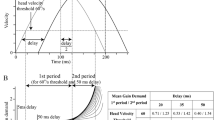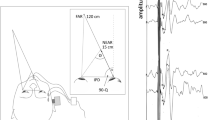Abstract
High-frequency head rotations in the 2–20 Hz range and passive, unpredictable head acceleration impulses were produced by a new technique, utilizing a helmet with a torque motor oscillating a mass. Unrestrained head and eye movements were recorded using magnetic sensor coils in a homogeneous magnetic field. In order to analyze the influence of the visual system on the vestibulo-ocular reflex (VOR), we took measurements under three experimental conditions: (1) with a stationary visual target; (2) in total darkness with the subject imagining the stationary target; and (3) with a head-fixed target. The results in 15 healthy subjects were highly consistent. At 2 Hz, VOR gain was near unity; above 2 Hz, VOR gain started to decrease, but this trend reversed beyond 8 Hz, where the gain increased continuously up to 1.1–1.3 at 20 Hz. Phase lag increased with frequency, from a few deg at 2 Hz to about 45 degrees at 20 Hz. Above 2 Hz, VOR gain was not significantly different for the three experimental conditions. Head acceleration impulses produced a VOR with near-unity gain in both directions. We also tested three subjects with clinically total bilateral loss of labyrinthine functions. These labyrinthine-defective subjects showed, in comparison to the normal subjects, strikingly lower gains and much longer delays in the VOR during sinu-soidal and step-like head movements. These results suggest that our new torque-driven helmet technique is effective, safe and convenient, enabling the assessment of the VOR at relatively high frequencies where both visual and mental influences are minimized.
Similar content being viewed by others
References
Barlow D, Freedman W (1980) Cervico-ocular reflex in the normal adult. Acta Otolaryngol (Stockh) 89:487–496
Barnes GR, Forbat LN (1979) Cervical and vestibular afferent control of oculomotor response in man. Acta Otolaryngol (Stockh) 88:79–87
Barr CC, Schultheis LW, Robinson DA (1976) Voluntary, non-visual control of the human vestibulo-ocular reflex. Acta Otolaryngol (Stockh) 81:365–375
Bles W, de Jong JM, Rasmussens JJ (1984) Postural and oculomotor signs in labyrinthine-defective subjects. Acta Otolaryngol (Stockh) 406:101–104
Chambers BR, Mai M, Barber HO (1985) Bilateral vestibular loss, oscillopsia, and the cervico-ocular reflex. Otolaryngol Head Neck Surg 93:403–407
Collewijn H (1977) Eye and head movements in freely moving rabbits. J Physiol (Lond) 266:471–498
Collewijn H, Van der Mark F, Jansen TC (1975) Precise recording of human eye movements. Vision Res 15:447–450
Cooper S, Eccles JC (1930) The isometric responses of mammalian muscles. J Physiol (Lond) 69:377–385
Dichgans J, Bizzi E, Morasso P, Tagliasco V (1973) Mechanisms underlying recovery of eye-head coordination following bilateral labyrinthectomy in monkeys. Exp Brain Res 18:548–562
Ditchburn RW, Ginsborg BL (1953) Involuntary eye movements during fixation. J Physiol (Lond) 119:1–17
Doerr M, Leopold HC, Thoden U (1981) Vestibulo-ocular reflex (VOR), cervico-ocular reflex (COR) and its interaction in active head movements. Arch Psychiatr Nervenkr 230:117–127
Dupuis H, Hartung E (1980) Ermittlung des biomechanischen Schwingungsverhaltens menschlicher Bulbi mit Video-Technik. Albrecht von Graefes Arch Klin Ophthalmol 213:245–250
Fineberg R, O'Leary DP, Davis LL (1987) Use of active head movements for computerized vestibular testing. Arch Otolaryngol Head Neck Surg 113:1063–1065
Gauthier GM, Piron JP, Roll JP, Marchetti E, Martin B (1984) High-frequency vestibulo-ocular reflex activation through forced head rotation. Aviat Space Environ Med 55:1–7
Goebel JA, Rowdon DP (1992) Utility of headshake versus wholebody VOR evaluation during routine electronystagmography. Am J Otol 13:249–253
Gresty MA, Hess K, Leech J (1977) Disorders of the vestibulo-ocular reflex producing oscillopsia and mechanisms compensating for loss of labyrinthine function. Brain 100:693–716
Grossman GE, Leigh RJ, Abel LA, Lanska DJ, Thurston SE (1988) Frequency and velocity of rotational head perturbations during locomotion. Exp Brain Res 70:470–476
Halmagyi GM, Curthoys IS, Cremer PD, Henderson CJ, Todd MJ, Staples MJ, D'Cruz DM (1990) The human horizontal vestibulo-ocular reflex in response to high-acceleration stimulation before and after unilateral vestibular neurectomy. Exp Brain Res 81:479–490
Huygen PLM, Verhagen WIM, Nicolasen MGM (1991) Cervico-ocular reflex enhancement in labyrinthine-defective and normal subjects. Exp Brain Res 87:457–464
J.C. (1952) Living without a balancing mechanism. N Engl J Med 246:458–460
Kasai T, Zee DS (1978) Eye-head coordination in labyrinthine-defective human beings. Brain Res 144:123–141
Kasteel-van Linge A, Maas AJJ (1990) Quantification of visuovestibular interaction up to 5.0 Hz in normal subjects. Acta Otolaryngol (Stockh) 110:18–24
Khater TT, Quinn KJ, Pena J, Baker JF, Peterson BW (1993) The latency of the cat vestibulo-ocular reflex before and after shortand long-term adaptation. Exp Brain Res 94:16–32
Leigh RJ, Sawyer RN, Grant MP, Seidman SH (1992) High-frequency vestibulo ocular reflex as a diagnostic tool. Ann N Y Acad Sci 656:305–314
Leopold HC, Doerr M, Oepen G, Thoden U (1982) The effect of cervical and vestibular reflexes on eye movements in Huntington's chorea. Arch Psychiatr Nervenkr 231:227–234
Lisberger SG (1984) The latency of pathways containing the site of motor learning in the monkey vestibulo-ocular reflex. Science 225:74–76
Lorento de Nó R (1933) Vestibulo-ocular reflex arc. Arch Neurol Psychiatry 30:245–291
Martins AJ, Kowler E, Palmer C (1985) Smooth pursuit of small-amplitude sinusoidal motion. J Opt Soc Am A 2:234–242
O'Leary DP, Davis LL (1990) Vestibular autorotation testing of Meniere's disease. Otolaryngol Head Neck Surg 103:66–71
O'Leary DP, Davis LL, Maceri DR (1991) Vestibular autorotation test asymmetry analysis of acoustic neuromas. Otolaryngol Head Neck Surg 104:103–109
Pozzo T, Berthoz A, Lefort L (1990) Head stabilization during various locomotor tasks in humans. I. Normal subjects. Exp Brain Res 82:97–106
Pulaski PD, Zee DS, Robinson DA (1981) The behavior of the vestibulo-ocular reflex at high velocities of head rotation. Brain Res 222:159–165
Robinson DA (1963) A method of measuring eye movement using a scleral search coil in a magnetic field. IEEE Trans Biomed Electron 10:137–145
Robinson DA (1964) The mechanics of human saccadic eye movement. J Physiol (Lond) 174:245–264
Rodenburg M, Kasteel-van Linge A, Maas AJJ (1987) Coordination of head and eye position during fixation. In: O'Regan JK, Lévy-Schoen A (eds) Eye movements: from physiology to cognition. Elsevier, Amsterdam pp 211–218
Rubens SM (1945) Cube-surface coil for producing a uniform agnetic field. Rev Sci Instrum 16, 243–245
Schwarz DW (1986) Physiology of the vestibular system. In: Cummings CW, et al (ed) Otolaryngology — head and neck surgery. Mosby, St. Louis pp 2679–2721
Serway RA (1983) Physics for scientists and engineers with Modern Physics. Saunders College Publishing, Philadelphia, pp 266–269
Skavenski AA, Hansen RM, Steinman RM, Winterson BJ (1979) Quality of retinal image stabilization during small natural and artificial body rotations in man. Vision Res 19:675–683
Stott JRR (1984) The vertical vestibulo-ocular reflex and ocular resonance. Vision Res 24:949–960
Szentágothai J (1950) The elementary vestibulo-ocular reflex arc. J Neurophysiol 13:395–407
Takemori S, Suzuki J (1971) Eye deviations from neck torsion in humans. Ann Otol Rhinol Laryngol 80:439–444
Thoden U, Doerr M, Leopold HC (1983) Motion perception of head or trunk modulates cervico-ocular reflex (COR). Acta Otolaryngol (Stockh) 96:9–14
Tomlinson RD, Saunders GE, Schwarz DWF (1980) Analysis of human vestibulo-ocular reflex during active head movements. Acta Otolaryngol (Stockh) 90:184–190
Vercher JL, Gauthier GM, Marchetti E, Mandelbrojt P, Ebihara Y (1984) Origin of eye movements induced by high frequency rotation of the head. Aviat Space Environ Med 55:1046–1050
Wilson VJ, Melvill Jones G (1979) Mammalian Vestibular Physiology. Plenum Press, New York
Author information
Authors and Affiliations
Rights and permissions
About this article
Cite this article
Tabak, S., Collewijn, H. Human vestibulo-ocular responses to rapid, helmet-driven head movements. Exp Brain Res 102, 367–378 (1994). https://doi.org/10.1007/BF00227523
Received:
Accepted:
Issue Date:
DOI: https://doi.org/10.1007/BF00227523




